This is a very rough guide to loudspeaker measurement and design, and by no means the only approach. It is not extensive, because it was something I wrote up quickly to help a fellow forumite along his (then) new journey in speaker design.
In my experience, there are two things that can make or break a system:
1) Choosing the wrong crossover frequencies
2) Wrong voicing
That is, assuming you have a good enclosure with good drivers.
Choosing the wrong crossover frequencies
I choose crossover frequencies primarily based on distortion profile of the drivers, and a close second comes off-axis response. Sometimes, as in the example I show here, there is a bit of a compromise. The distortion criterion is so that the system always sounds clean and dynamic. Off-axis considerations is for achieving a smooth power response.
Wrong voicing
In simpler terms: frequency response. But, specifically, the response you control when you design the crossover. A system can sound bright & thin or dark & heavy, depending on the spectral balance you choose for it. Here I must mention the effect of room acoustics: a speaker with flat frequency response can sound clinical, even harsh in a live room. As a DIY project you can choose to tilt down the mid and upper frequencies in such a situation. Not ideal (acoustic treatment would have been best), but it is better than having an expensive speaker that sounds like a cheap one.
So, here are my steps (some of them):
1) Measure far-field tweeter
2) Measure far-field midrange
3) Measure far-field woofer
4) Measure far-field tweeter+midrange paralleled
5) Measure far-field midrange+woofer paralleled
Do all of the above without moving the microphone; mic must be on the design axis. If you have enough open space to do a 2m measurement, this is great. I personally have to settle for 1-1.2m mic distance.
6) Measure near-field tweeter
7) Measure near-field midrange
8) Measure near-field woofer
9) Scale down and splice low frequency near-field data to far-field measurements for the respective drivers, excluding the two summed response measurements. For the woofer, use the "10Hz" procedure here White Paper - Accurate In-Room Frequency Response to 10Hz.pdf, which includes the baffle step simulation (I have not done this in these measurements).
10) Measure the impedance curves of all the drivers
11) In the crossover design software, simulate a system response for the tweeter and midrange in parallel. Overlay the measured (actual) "tweeter+midrange paralleled" response on the simulated response. They should be identical above the gated frequency (which could have been around 300Hz). By doing this, you confirm that (a) your measurement data is good and (b) the simulation software works as expected.
12) If your crossover design software allows for it, you can make a more advanced measurement model by deriving "SPL & minimum phase + relative acoustic offset" model. This requires that you generate a Hilbert transform on the SPL data, which produces a minimum phase response, but which is useless without additionally having the relative acoustic offset between drivers.
Here are the frequency response curves of 3 drivers:
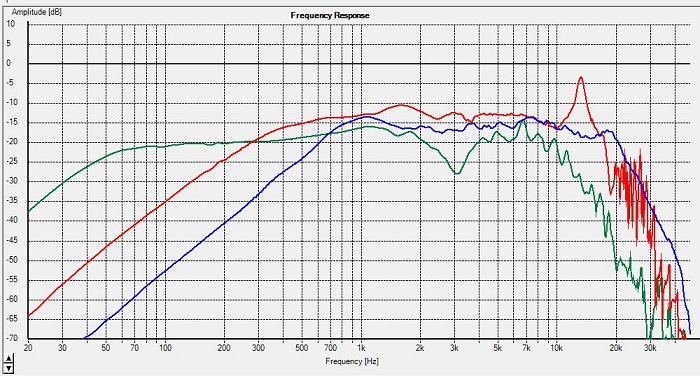
This their distortion profiles:
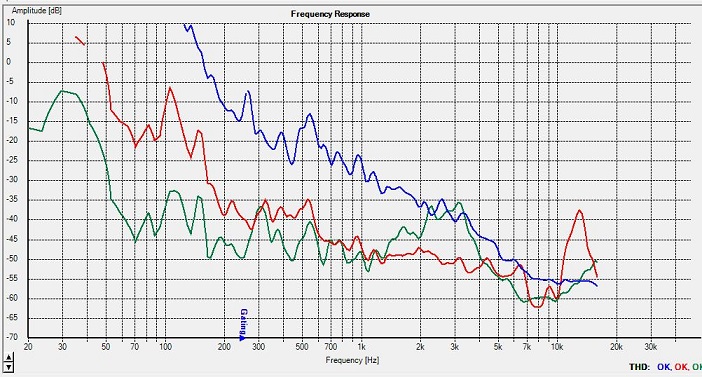
I chose crossover frequencies of 700Hz and 3.5kHz. Distortion of the tweeter is rising, but not poor at that frequency. However, I did not want to go higher, due to the midrange's falling off-axis response in that region.
Midrange off-axis:
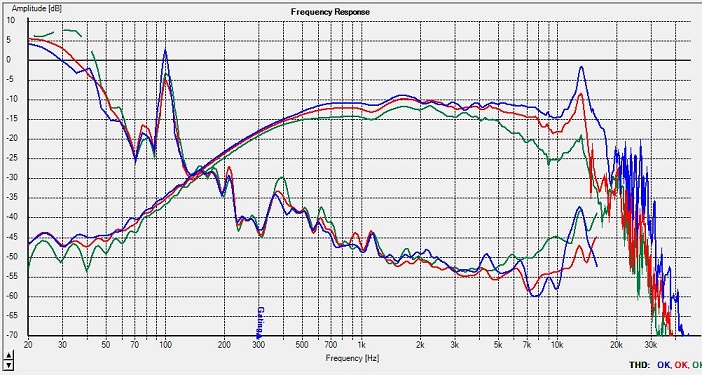
Final system response:
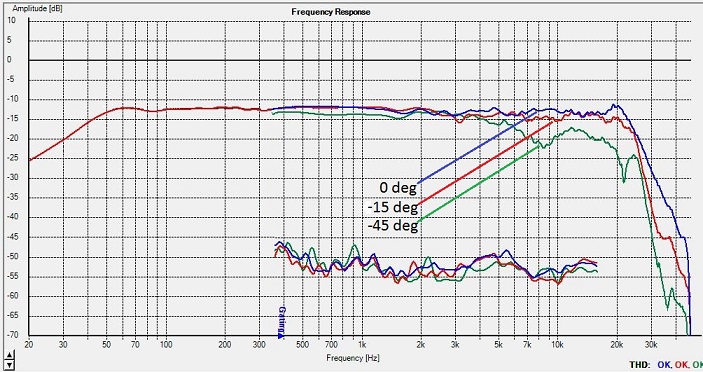
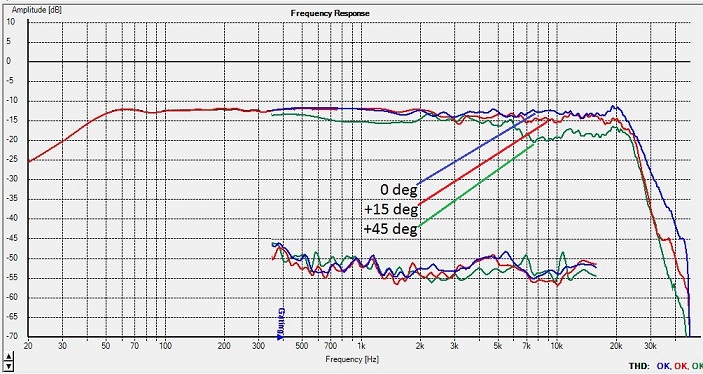
Hope this helps!
PS: In SpeakerWorkshop's help files there is a nice 2-way demo project, but the last time I tried to look at it I found that the help file format is not compatible with Windows 7.
In my experience, there are two things that can make or break a system:
1) Choosing the wrong crossover frequencies
2) Wrong voicing
That is, assuming you have a good enclosure with good drivers.
Choosing the wrong crossover frequencies
I choose crossover frequencies primarily based on distortion profile of the drivers, and a close second comes off-axis response. Sometimes, as in the example I show here, there is a bit of a compromise. The distortion criterion is so that the system always sounds clean and dynamic. Off-axis considerations is for achieving a smooth power response.
Wrong voicing
In simpler terms: frequency response. But, specifically, the response you control when you design the crossover. A system can sound bright & thin or dark & heavy, depending on the spectral balance you choose for it. Here I must mention the effect of room acoustics: a speaker with flat frequency response can sound clinical, even harsh in a live room. As a DIY project you can choose to tilt down the mid and upper frequencies in such a situation. Not ideal (acoustic treatment would have been best), but it is better than having an expensive speaker that sounds like a cheap one.
So, here are my steps (some of them):
1) Measure far-field tweeter
2) Measure far-field midrange
3) Measure far-field woofer
4) Measure far-field tweeter+midrange paralleled
5) Measure far-field midrange+woofer paralleled
Do all of the above without moving the microphone; mic must be on the design axis. If you have enough open space to do a 2m measurement, this is great. I personally have to settle for 1-1.2m mic distance.
6) Measure near-field tweeter
7) Measure near-field midrange
8) Measure near-field woofer
9) Scale down and splice low frequency near-field data to far-field measurements for the respective drivers, excluding the two summed response measurements. For the woofer, use the "10Hz" procedure here White Paper - Accurate In-Room Frequency Response to 10Hz.pdf, which includes the baffle step simulation (I have not done this in these measurements).
10) Measure the impedance curves of all the drivers
11) In the crossover design software, simulate a system response for the tweeter and midrange in parallel. Overlay the measured (actual) "tweeter+midrange paralleled" response on the simulated response. They should be identical above the gated frequency (which could have been around 300Hz). By doing this, you confirm that (a) your measurement data is good and (b) the simulation software works as expected.
12) If your crossover design software allows for it, you can make a more advanced measurement model by deriving "SPL & minimum phase + relative acoustic offset" model. This requires that you generate a Hilbert transform on the SPL data, which produces a minimum phase response, but which is useless without additionally having the relative acoustic offset between drivers.
Here are the frequency response curves of 3 drivers:

This their distortion profiles:

I chose crossover frequencies of 700Hz and 3.5kHz. Distortion of the tweeter is rising, but not poor at that frequency. However, I did not want to go higher, due to the midrange's falling off-axis response in that region.
Midrange off-axis:

Final system response:


Hope this helps!
PS: In SpeakerWorkshop's help files there is a nice 2-way demo project, but the last time I tried to look at it I found that the help file format is not compatible with Windows 7.
